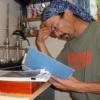-
Posts
1,171 -
Joined
-
Last visited
Reputation Activity
-
 jud reacted to mtaylor in Laminating wood question
jud reacted to mtaylor in Laminating wood question
I'll try that Jud. I've been squeezing the blank halves with clamps and then putting them under the glass.
Insanity.. doing the same thing over and over and expecting different results.
-
 jud got a reaction from grsjax in Wood toxicity
jud got a reaction from grsjax in Wood toxicity
Dust masks are good to use if you have your nose down near your sanding or when you are generating large amounts of dust suspended in the air. Don't need to worry about a dust mask if you let your nose hair grow naturally, that hair is there to protect you from dust. The one I watch closely is the consumption of tomatoes. It is a proven fact that everyone who ate tomatoes, raw or cooked in 1859 are dead now, I'm not taking any chances.
jud
-
 jud got a reaction from NMBROOK in Wood toxicity
jud got a reaction from NMBROOK in Wood toxicity
Dust masks are good to use if you have your nose down near your sanding or when you are generating large amounts of dust suspended in the air. Don't need to worry about a dust mask if you let your nose hair grow naturally, that hair is there to protect you from dust. The one I watch closely is the consumption of tomatoes. It is a proven fact that everyone who ate tomatoes, raw or cooked in 1859 are dead now, I'm not taking any chances.
jud
-
 jud reacted to Modeler12 in A third hand for high places
jud reacted to Modeler12 in A third hand for high places
I got this idea from J. Ponto.
In the past I have had problems seizing or attaching blocks to spars or other places that are high up on the ship.
I took an old desk lamp, gutted the cord and socket and replaced that with some extensions and a special fixture on top.
I had this small Sony tripod that I never use, took off the legs and adapted it to a small C-clamp. Now I have numerous ways of twisting, turning and reaching those awkward places with a hemostat or other tool that clamps as shown above. In order to use it at deck level, I simply take off one or two of the extensions.
Thanks Ponto.
-
 jud got a reaction from olliechristo in what is the ideal modelling table?
jud got a reaction from olliechristo in what is the ideal modelling table?
Forget the swivel top, walk around it instead. If you tilt the top, which may be handy, you will need a separate tool table on wheels so you can easily take it with you as you travel around the main table, might put some sort of a fold down seat on the tool table that allows sitting at the required height. If you have air, run a line in there with your overhead wiring, lights and vacuum, all offset from the table at one place, close but clear of the table. That should be enough to cause you to rub a bald spot in your hair.
jud
-
 jud reacted to mtaylor in Cutty Sark by NenadM
jud reacted to mtaylor in Cutty Sark by NenadM
Nenad,
Can you get a flat lacquer where you are? Or a matte finish spray.... maybe from a craft store? That might give you the finish you are seeking.
As for life's philosophy, I think you've got it" Chill out, man, be cool, be cool be cool. You'll make it all, with or without anxiety, and better without. Be aware that somewhere around the corner waiting in ambush hearth attack or brain stroke, and you smoke so much ... It's just hard to change, isn't it? I'm still trying to change some things.
Building ships is a good bit of that philosophy. No stress, no anxiety, just thought, problem-solving, and art. The spice must flow, but so must the creative part of us. You are doing impressive work, my friend.
-
 jud reacted to Chuck Seiler in plank entire second layer length with one strip?
jud reacted to Chuck Seiler in plank entire second layer length with one strip?
Another solution is to use a single plank for the strake, then score butt joints into the plank at the appropriate lengths and locations.
-
 jud got a reaction from Senior ole salt in Why do hot guns jump violently?
jud got a reaction from Senior ole salt in Why do hot guns jump violently?
We were not dealing with cast iron and an unloaded hot gun was not attacked with buckets of seawater, we would have used hoses. Destroying a hot barrel with copious amounts of sea water would only be done to attempt to prevent an explosion in the bore, caused by heat cooking off the explosives in the projectile. If a projectile could not be removed from a hot gun, the cooking off of the projectile was a real danger. Hot guns and explosive projectiles spending much time in them are dangerous, a propelling charge cooking off was not desired but not as dangerous, it would just clear the bore. I have experienced misfires in hot guns, was successful in re-cocking the firing pin and lucky enough for the round to fire. I have also attempted to re-cock and attempted to fire unsuccessfully with warm guns, waited 30 minutes to avoid the possibility that it was not a miss-fire but a hang fire instead, then opened the breach and extracted the round from the chamber, always a nervous time. First time I experienced a miss fire as Mount Captain was on a 3" 50 aboard a Heavy Cruiser, I cleared the mount as instructed but I remained with the gun, the Warrant Gunner came up to the gun and we waited our 30 minuets then I very carefully opened the breach, caught the rear of the case and worked it clear of the loader and handed it to the gunner. Horror of Horrors, he upended that round, thumped the primer with his finger and tossed the round overboard while saying defective primer, "even throwing a live round overboard required that the round hit the water case down, if it hit projectile down and the propellent went off, the case would act as a rocket and come back, case down prevented that". Never needed to hose down a hot gun but was prepared to do so quickly if needed. Closest to a projectile exploding in a bore was in RVN, firing old WW 2 ammo while supporting PBR's in a firefight. Just firing the right gun of a water cooled twin 40 MM, after about 20 rounds the gun made more of a cough than a bang, recoil was short and the projectile blew up just clear of the bore, the shrapnel dispersed in a half moon shape ahead of the gun, none came back towards us that we knew about. The gun quit working so I shifted to the left gun and resumed firing, that kept the rounds going out and didn't allow the loaders to get rattled. When I had time I investigated and found a split cartridge case and broken extractors in the gun, replace the extractors and that gun was up and working. The smoke that the propellent of that round produced was a rotten smell unlike the norm.
I still do not believe that the guns of old, jumped when fired as designed, I have fired to many guns to believe that. Black powder and smokeless powder do have different burning rates under pressure, but neither stay in the bore of a hot gun long enough to change the characteristics of their burn rates. If a gun starts to appear to jump as it warms up, it is because of outside forces or conditions having an effect on normal recoil. There is a reason why no one has came forward with a scientific explanation of jumping guns, that is because there is none. Trails on field guns will work their way deeper on each firing unless they are re fired from the position reached at the end of recoil, but the practice was to push them back into battery, that recoil and pushing back into battery would disturb the ground, the trails would be deeper and in soft ground the wheels would be worked deeper and deeper into the ground. Aboard ship the jumping would destroy the wooden wheels and tear up the deck as well as pulling the breaching and its rings out of the bulkhead, carronades would destroy their mounting platforms. Think there is a model of a small boat on this site, with a cannon mounted with a track built into the boat to allow the working of the gun and free recoil, If it was normal for guns to jump, they would not be staying in those tracks.
Kind of a windy post, I will not be insulted or distressed if the Moderators choose to remove it, may do it myself later.
jud
-
 jud got a reaction from Sailcat in Cutty Sark by Sailcat - FINISHED - Revell - 1/96 - PLASTIC - Rescue kit bash morphed to Dame Tisane
jud got a reaction from Sailcat in Cutty Sark by Sailcat - FINISHED - Revell - 1/96 - PLASTIC - Rescue kit bash morphed to Dame Tisane
I prefer to do bench work standing up using a bench I can walk around, a stout island on wheels with brakes is what I am thinking about. With a heavy mobile island and a regular work bench I could have the best of two worlds. I have two different work benches at different heights, so I usually stand up when working with leather.
jud
-
 jud reacted to NMBROOK in Why do hot guns jump violently?
jud reacted to NMBROOK in Why do hot guns jump violently?
Totally agree with you on this one Chris.Many of the models I build have internal decks but no accurate drawings exist for the layout.I try to calculate the serviceable area required for the armament and develop the interior around this.This not only applies to obstructions,but also to deck levels as several of the works by Van de Velde I use for reference do compromise feasability.
Kind Regards
Nigel
-
 jud got a reaction from flying_dutchman2 in Why do hot guns jump violently?
jud got a reaction from flying_dutchman2 in Why do hot guns jump violently?
Agree with Spyglass, Guns recoil, cold or hot when fired. Often after ships guns were heated up, they would double shot them. Double shoting a cold gun often caused a failure, double shoting would cause more recoil. Getting sloppy when using black powder can cause a a gun tube to fail. The reason projectiles are rammed hard against the black powder charge is that the power curve of black powder goes high quickly and there needs to be a instant reaction on the projectile to get it moving before that power peak is reached, if not rammed hard against the charge, voids will fill up with pressure before the projectile starts to move and the short time to do that delays projectile movement enough to make a bomb out of the gun. Smokeless powder takes more time to peak, that time gives the projectile time to start moving after the voids are filled with pressurized gas and before the pressure peak. Pick up a black powder cartridge and shake it, because the powder fills the case and often is a compressed charge, shaking will not create the sound of powder moving around. Smokeless powder seldom fills the case and not often compressed, shaking the cartridge will produce the sound of powder moving around inside the cartridge case. Sorry for the windy response.
jud
-
 jud reacted to Stockholm tar in Why do hot guns jump violently?
jud reacted to Stockholm tar in Why do hot guns jump violently?
Then again, can we actually trust midshipman Dillon's account? He says that at times the lower deck 'was at times so completely filled with smoke', so how can we be sure the guns 'nearly kicked the upper deck beams' as he says?
With the 'excitement' of battle, may he not be 'guilding the lily' somewhat in his account – which we can put down to the exuberance of youth? Also, how much later after the battle did he record this – long enough for him to add a little embellishment perhaps?
Of course, he may be telling the truth – but I'm not 100% convinced.
-
 jud reacted to NMBROOK in Why do hot guns jump violently?
jud reacted to NMBROOK in Why do hot guns jump violently?
Having recently read Richard Ensor's 'Restoration warship' he does state that recoil was far more violent with bronze cannons,than with iron.An absolute mountain of research went into the book,so I am inclined to agree with him.He doesn't go in to any great reasoning other than to say that many bronze cannon's would develop stress fractures in service which would worsen the problem.I know the time period being generally discussed is perhaps a little later and concerns iron cannons but thought I would add this as it is relevant.
Kind Regards
Nigel
-
 jud got a reaction from newbuilder101 in Making cannons from non-traditional materials
jud got a reaction from newbuilder101 in Making cannons from non-traditional materials
You asked the right person. I have read that for Green Sand molds, wheat flour is dusted into the mold as a release agent, turns to charcoal during the pore.
jud
-
 jud got a reaction from KevinR in Name the Ship Game
jud got a reaction from KevinR in Name the Ship Game
Had Ammo delivered by a vessel that looks like this on in RVN, " Uss Brule AKL 28", sometimes she delivered twice a week, it was a small WW 2 cargo ship and there were a lot of them used in the Pacific to move cargo around that did not justify an full blown AKA. The Brule while delivering ammo was hit with 7 recoil-less rifle rounds, 'some records say rockets, but the crew at the time said recoil less rifles', she had a hold full plus a deck load of ammo for us. A fire was started in the deck load of ammo but they got it out. Needed to inspect every round from that delivery and even then I had a 40 MM round just clear the bore and explode, the shrapnel in the water was a half moon shape away from the gun, split the case and broke the extractors, glad to shoot the last of that load. Believe the Pueblo was a converted vessel of the same type, was on the rivers in RVN when she was taken and we didn't know if it would effect the mess we were involved in. Probably some of those vessels were converted to Buoy tenders after the war, they might have been commissioned as such.
jud.
-
 jud got a reaction from alexmd in How to build a wood case ?
jud got a reaction from alexmd in How to build a wood case ?
Cutting such a groove using a router can be done several ways, both require a jig of sorts, one holds the stock and provides a surface for the router to be guided and moved along the desired cut and the other holds the router and used the bit or a fence. I used a 1" X 12" pine board with a round hole cut in the board that allowed the router to be held upside down, the hole I cut left a flange for the router to rest on with the face plate of the router flush with the board surface with the router clamped into the jig from the bottom. The whole thing was clamped to a riser that I had built. I used that setup with the router bits guiding the board for shaped edges and for groves use a fence type guide, just a board clamped on. My router went into that cobbled up thing several times over the years. Router tables used to be available that did the same thing, don't think they were very expensive. I would have bought one if they were available when I had the need and made my own. Many old windows just had a notch cut in the inside edge of the window framing and a small square or quarter round strip was tacked in to hold the glass, that allowed room for the wood to move with changing humidity without putting stress on the glass, when putty was used, tabs held the glass instead of wood strips.
jud
-
 jud reacted to captainbob in cable laid vs rope (left vs right twist)
jud reacted to captainbob in cable laid vs rope (left vs right twist)
Let me add to the confusion. This is from a dictionary. “Common twisted rope generally consists of three strands and is normally right-laid, or given a final right-handed twist.
The ISO 2 standard uses the uppercase letters S and Z to indicate the two possible directions of twist, as suggested by the direction of slant of the central portions of these two letters. The handedness of the twist is the direction of the twists as they progress away from an observer. Thus Z-twist rope is said to be right-handed, and S-twist to be left-handed.”
The strength of a rope has to do with how parallel the strands are with the length of the rope and has nothing to do with which way it is twisted.
Bob
-
 jud reacted to grsjax in Thimble help needed
jud reacted to grsjax in Thimble help needed
You can also use low temperature melting metals to fill the copper tube and when finished forming heat the copper to remove the core metal.
-
 jud got a reaction from usedtosail in Proxxon Micro MBS 240/E Band Saw Review
jud got a reaction from usedtosail in Proxxon Micro MBS 240/E Band Saw Review
I like the guide bearings on that saw except for the one below the table. I bought a cheap band saw with soft metal blocks used for the blade guides both above and below the table, never licked it much. Might be a good saw if I rebuild the guides now that I am semi retired and have some time. Good Grief, just started to count the things I want to get done now that I have more time, going to need to set priority's, that saw will be near the bottom of the list.
I purchased my drafting table self healing drawing pad from an instrument company that sold sextants, surveying instruments as well as drafting supply's. It was 4 feet X 7 feet when purchased, had to downsize the table to a little under 6 feet wide and 3 1/2 feet deep a few years ago. Have had this cover about 14 years, a smaller one that I had purchased a few years earlier is still being used on a desk. The material was available at any length from differentl width rolls that the company had in stock, just cut what you need, the price if I remember right was about $ 12/foot. My drafting table top is a solid core hospital door that I bought from salvage, Bought a piano hinge and mounted the door to a large steel desk, put the pad on and added a drafting machine and ended up with a 400lb +/- drafting table, a pain to move but a good solid table. I would look for a pad at an office supply house that also sells drafting tools for a pad, bet you could get along without the printed grid without much hardship and the cost probably would be much cheaper than a hobby shop offering.
jud
-
 jud got a reaction from WackoWolf in Proxxon Micro MBS 240/E Band Saw Review
jud got a reaction from WackoWolf in Proxxon Micro MBS 240/E Band Saw Review
I like the guide bearings on that saw except for the one below the table. I bought a cheap band saw with soft metal blocks used for the blade guides both above and below the table, never licked it much. Might be a good saw if I rebuild the guides now that I am semi retired and have some time. Good Grief, just started to count the things I want to get done now that I have more time, going to need to set priority's, that saw will be near the bottom of the list.
I purchased my drafting table self healing drawing pad from an instrument company that sold sextants, surveying instruments as well as drafting supply's. It was 4 feet X 7 feet when purchased, had to downsize the table to a little under 6 feet wide and 3 1/2 feet deep a few years ago. Have had this cover about 14 years, a smaller one that I had purchased a few years earlier is still being used on a desk. The material was available at any length from differentl width rolls that the company had in stock, just cut what you need, the price if I remember right was about $ 12/foot. My drafting table top is a solid core hospital door that I bought from salvage, Bought a piano hinge and mounted the door to a large steel desk, put the pad on and added a drafting machine and ended up with a 400lb +/- drafting table, a pain to move but a good solid table. I would look for a pad at an office supply house that also sells drafting tools for a pad, bet you could get along without the printed grid without much hardship and the cost probably would be much cheaper than a hobby shop offering.
jud
-
 jud got a reaction from Julie Mo in A review of a Mini Mill from Little Machine Shop
jud got a reaction from Julie Mo in A review of a Mini Mill from Little Machine Shop
Come on, you've had 12 minutes to post some more, I sit in anticipation, trying to be patent.
jud
-
 jud reacted to Senior ole salt in Thimble help needed
jud reacted to Senior ole salt in Thimble help needed
Thanks for all the good tips in solving my problem. I decided to go with the simplest, a kind of a combination of the suggestions above that is: Take a strip of copper (soft) cut about 3/32 wide and suitable length to make the desired eye. I filed one end to a sort of blade or better yet a "scarf". I then bent it around a twist drill with a 1/8" overlap. I then sodered the assembly together.
To mount it in place on the model I first formed the rope grommet,and seized it in the "thimble with thread. Right now it resides P & S on the model . If you look real close you can see the thimble has no flange, but tell anybody.
Thanks Pat,Jud,Ulises,Bart,Druxley,Antony
S.os
-
 jud got a reaction from Bindy in A review of a Mini Mill from Little Machine Shop
jud got a reaction from Bindy in A review of a Mini Mill from Little Machine Shop
Come on, you've had 12 minutes to post some more, I sit in anticipation, trying to be patent.
jud
-
 jud got a reaction from captainbob in Lettie G Howard by captainbob - FINISHED - 1:48 - POB - schooner
jud got a reaction from captainbob in Lettie G Howard by captainbob - FINISHED - 1:48 - POB - schooner
Might be a good time to try using a scraper on the deck instead of sandpaper, because of the pre-painting. Like what you are doing and the thoughtful skill that is revealed by your work.
jud
-
 jud got a reaction from WackoWolf in A review of a Mini Mill from Little Machine Shop
jud got a reaction from WackoWolf in A review of a Mini Mill from Little Machine Shop
Drop by, I have about 5 gallons of solvent in the shop, or you could use gasoline like we did when I was a kid to wash parts. If you have a buddy in auto or truck repair see if you can use their parts washer, save a lot of time and do a better job.
jud















